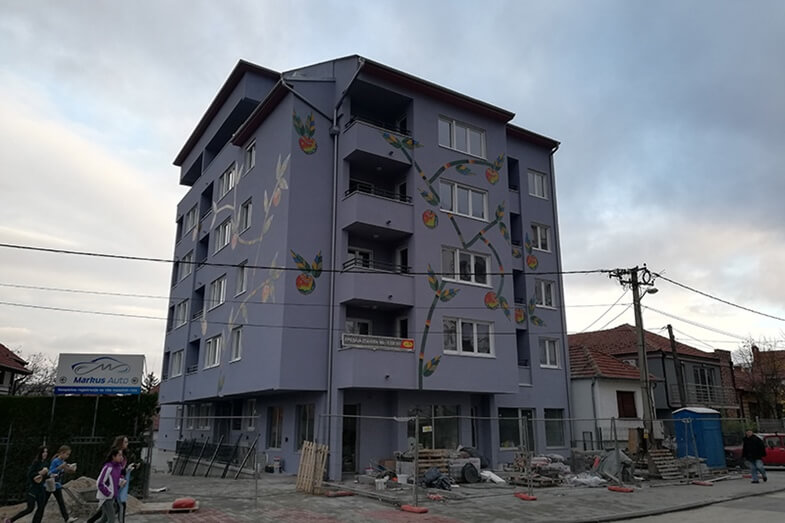
The most efficient solution for external and internal insulation of the whole building or its parts that are in contact with the ground is the use of so-called perimeter insulation.
It is external, continuous insulation without thermal bridges used for partition walls that are in direct contact with the ground.
Before starting to install thermal insulation, it is necessary to get acquainted with certain facts that are important in order for the insulation material to be adequately installed.
Types of external insulation and the best insulation materials
There are several thermal insulation systems. The rough division is that we divide the solutions for external and internal thermal insulation into the ones with contact and the ones without contact.
Non-contact thermal insulation systems are used for big and industrial buildings, while contact systems or Demit facades are used for residential buildings.
External thermal insulation involves the installation of thermal insulation panels on external walls. It is commonly used when insulating new buildings and houses or when renovating existing buildings.
If you notice any of the following problems in your home:
- Cold rooms even though you are heating them;
- Rapid cooling of the room after stopping the heating;
- The appearance of mold, moisture, condensation and fungi,
… Then it’s time to start installing the thermal facade. As experts, we recommend a contact facade.
Contact facade is the most common type of thermal protection. The insulation is attached directly to the wall of the building, from the outside.
Besides providing protection from the weather, they can also contribute to the durability of the wall itself. Rockwool is recommended in most cases, because of all the advantages it provides. Let’s see what other materials are used for thermal insulation.
What materials are used for thermal insulation?
Thermal insulation materials are among the synthetic and mineral materials. Styrofoam and Styrodur stand out as the most famous synthetics.
Styrodur is thicker and heavier than Styrofoam because a larger amount of air is injected into it between the polyurethane balls.
Mineral materials for thermal insulation are mineral wool, which can be rock, glass or wood.
Glass or rock mineral wool are insulating materials made of glass or rock – therefore of completely natural raw materials.
Wool is durable and unchanging. It is not flammable, in relation to Styrofoam, and has good characteristics when it comes to sound and heat insulation, because it allows the walls to “breathe
What makes rock wool even better than Styrofoam?
Just as we have said, mineral wool, whether glass or stone (rock), is obtained from natural raw materials – from stone or glass.
It consists of a series of intertwined fibers (shorter in stone wool, slightly longer in glass wool), which enable the ‘capture’ of a large amount of air within the products themselves.
And we know that air itself is actually the best insulator!
The properties of stone wool are permanent and do not change over time. It is a good sound insulator, and facades with stone wool are treated and classified as non-combustible facade systems.

It is vapor permeable and allows the walls to “breathe”.
Walls with wool “breathe”, that is, allow steam from the interior to come out, which is a very important advantage over other types of thermal insulation materials.
For example, Styrofoam provides about 30 to 40 times more resistance to the passage of water vapor than rock wool. The passage of water vapor is necessary in order not to create condensation and mold in the interior.
It is an extremely durable thermal insulation material
As stone wool originates from stone, its durability and invariability of characteristics are guaranteed over a longer period of time – regardless of the outside temperature.
So, this solution for thermal insulation of the house will last you as long as the house itself!
The incombustibility of rock wool is well known
Rock wool as a solution for external thermal insulation is considered to be a non-combustible system because it does not contribute to the spread of fire. In this way, we protect lives, property, and the environment.
How to choose a material for interior and exterior insulation?
When choosing a material for thermal insulation, it is necessary to consider several important factors. The choice of material is influenced by the climatic conditions of the area, as well as the microclimate in which the facility is located.
Apart from the fact that thermal insulation serves to protect from cold and heat, it also has other purposes. We must also take them into account when choosing materials.
It is necessary that the material is well permeable to steam and that it allows the space to breathe. This means that moisture escapes smoothly.
Thermal insulation materials will also protect us from fire. Therefore, you should choose those materials that are not flammable, or that quickly prevent the spread of flames.
When choosing a thermal insulation material, its quality and durability are important. There is also resistance to moisture, non-release of chemicals, and resistance to insects.
In addition to all these properties, thermal insulation materials should also be a good sound insulator, in order to protect against external noise or noise between rooms.
Why install thermal insulation?
Thermal insulation solutions are unavoidable if you are engaged in construction or you want your apartments and houses to be pleasantly warm during all months of the year.
In addition, by installing insulation, you save a lot of money on electricity, heating, cooling, repairing damage due to mold, etc. This saves more nerves.
Thermal insulation in the complexes built by GRADING provides optimal temperature in all rooms, permanent protection from moisture, and of course, energy efficiency.
With high-quality thermal insulation, we have greatly reduced heat losses during the winter and prevented overheating in the summer.
There will be no moisture in the apartments, no condensation, or mold, and all the occupants will breathe clean air!
Our buildings are also long-lasting because good thermal insulation affects the longevity of the building and mechanically protects it.
Installing exterior and interior insulation may seem difficult or complicated to you, but believe us, investing in your home and consequently the health of your family is the best investment you could ever start.
That’s why Grading is here to make it easier for you in everything related to living in an apartment building or a house. From ideas for interior design, tips for buying an apartment, and interesting texts like the one that shows you how life in a residential community works. Do not hesitate to contact us!





